Types of Welding Processes – Uses, Benefits and Applications
Updated: 29 Dec 2023
119
The welding processes have evolved over centuries, becoming a critical force for shaping infrastructure and an indispensable facet of modern industrial applications.
Welding has become one of the most used technologies in almost any manufacturing industry. It developed different welding methods to work with every sector according to their style and needs. These processes are employed to assemble and fabricate parts of those industries.
This industry’s different types of welds can’t be overstated as it continues to develop more and more efficiency and precision in producing most of its essential components. These welding techniques are improving as time passes, through which new technologies emerge.
Types of Welding Processes: Let’s Dive Inside:
Welding dates back centuries and has evolved with time and technology from early blacksmithing to today’s new high-tech fabrications. In the early days of welding, it was considered one man’s job, but now it is considered its technology, which has become a crucial industry.
Usually, welding is a foundational technique for metal fabrication and joining two metals, but it’s more than that in the contemporary world. The various welding processes are divided into different methods, which are correctly defined below.
Gas Metal Arc Welding:
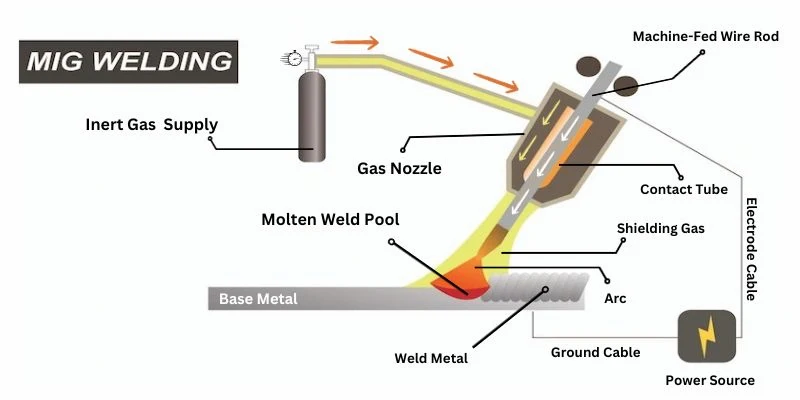
© weldingvilla.com – Image usage rights
GMAW represents gas metal arc welding and is commonly known as MIG welding. The GMAW has a normal welding process utilizing a continuous wire electrode fed through a proper welding gun. The welding is smooth and effective but is considered sensitive to different factors like rain, dust, and wind.
The wire melts from the welding gun, and there is a shielding gas that helps to protect the weld pool from atmospheric contamination. The gas is usually a mixture of Argon and CO2. This welding process is versatile, which allows the welders to achieve high productivity. This MIG welding process is also suitable and recommended for various materials with enough thickness.
| Benefits: |
|---|
The following are the benefits of Gas Metal Arc Welding, which we have covered in a few points.
|
Applications:
Gas metal arc welding is widely used in metal industries that manufacture automotive, construction, and general-purpose fabrication. You can also use it for normal welding due to its speed and efficiency, but make sure to use it with the proper materials.
Gas Tungsten Arc Welding:

© weldingvilla.com – Image usage rights
Gas tungsten arc welding, also known as Tig welding, has the same process as MIG welding but with few changes. The GTAW employs a non-consumable tungsten electrode to create the arc for welding. The filler material is then added separately if needed. The process is conducted in a shielding gas environment, usually argon, but it can be changed depending on the required metals.
TIG welding is precise welding due to its precise control over any welding parameters. That’s why it is suitable and recommended for applications that require high-quality welds. It can be used with any material but is mostly recommended to be used with thin materials because of high-quality precision.
| Benefits: |
|---|
Check out the below list of advantages Tungsten Arc Welding is famous for:
|
Application:
It is commonly used in places where precision is required and focuses on—used in aerospace and other thin materials like stainless steel.
Submerged Arc Welding:
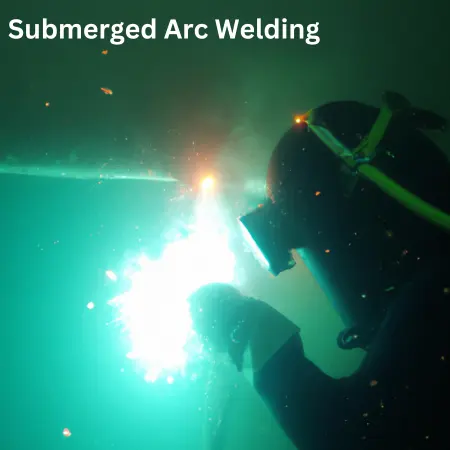
© weldingvilla.com – Image usage rights
This type of welding is called submerged due to a reason because it involves submerging the arc and the welding zone beneath a layer of granular flux.
You may ask why they do that to prevent it from forming atmospheric contaminants, resulting in deep, high-quality welds. This process is best for thick-section welding due to its high deposition rates.
Submerged arc welding is a safe process because it doesn’t produce fumes, and you will be protected from welding emissions. This welding is considered safe because it has a layer of flux, which keeps the welder safe from infrared radiation, but is also strong and recommended for deep penetrations.
| Benefits: |
|---|
Below are a few advantages list of Submerged Arc Welding that can cover your thoughts about it:
|
Applications:
This SAW is widely used in the construction and manufacturing of heavy machinery like ships and other thick structural steel fabrication.
Plasma Arc Welding:
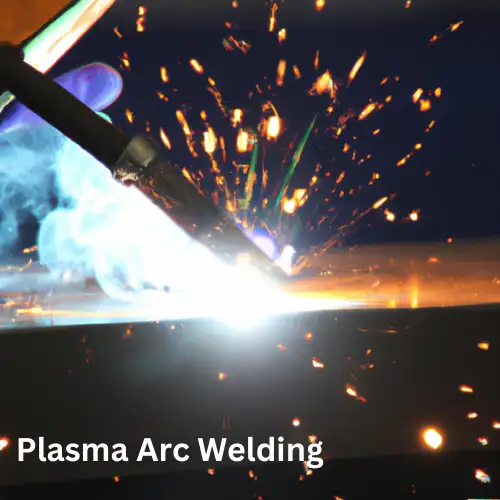
© weldingvilla.com – Image usage rights
In plasma arc welding, you mainly focus on plasma arc for your welding. This welding process is precise and versatile, making it effective for both thick and thin materials. Plasma arc welding can be used both autogenously and as filler material.
The shielding gas used for this process combines argon and hydrogen. It also uses helium gas for different occasions. The weld in this welding process is solid due to exposure to extreme heat, making it even stronger.
| Benefits: |
|---|
Check out the trendy advantages of Plasma Arc Welding in the below list:
|
Applications:
It is commonly responsible for welding thin materials in many industries, especially in aerospace. It can also be used for welding thin materials in electronics and other medical device manufacturing.
Resistance Spot Welding:
As it is clear from its name, it uses resistance to create spot welding. The process of RSW applies pressure and heat at localized points, making spot welds. This method is mainly used in the manufacturing sector and is very efficient and effective.
Resistance spot welding is widely used in automotive industries for joining different metal sheet components efficiently and quickly.
This Resistance spot welding is energy efficient because it uses less possible electricity. Unlike previous and other welding, it doesn’t require shielding gas, which makes it a clean process.
| Benefits: |
|---|
All the benefits of the Resistance Spot welding are given below:
|
Applications:
Its primary focus of usage is the accessibility of manufacturing parts. Resistance Spot welding is usually used in automotive, where it’s accessible to different body parts.
Flux-Cored Arc Welding:
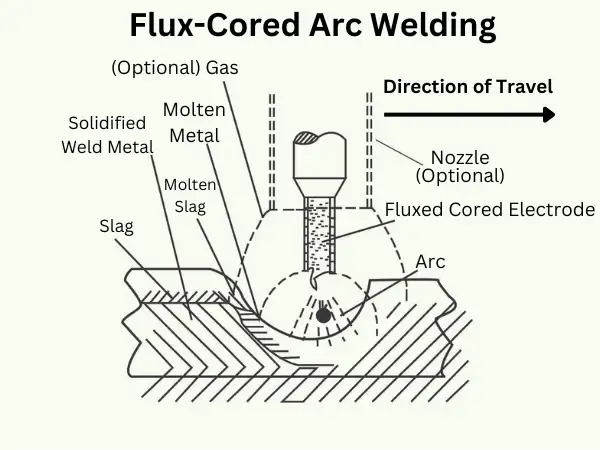
© weldingvilla.com – Image usage rights
The flux core arc welding is the same as MIG welding but has a tubular wire filler with a flux. The flux in this process generates a shielding gas upon melding, which protects the weld from contamination.
Like other welding, flux core welding requires shielding gas in some situations. The shielding gas is a mixture of CO2 and Argon with a proper balance rate. This shielding gas can influence the whole welding process, which includes arc stability and spatter level.
Some types of flux core welding don’t require any external gas, which makes them easy to use even outdoors, other than welding in the workshop, and you don’t have to worry about welding fool contaminations.
| Benefits: |
|---|
The Fluxed Core Welding advantages are listed below:
|
Applications:
Its common use for construction involves shipbuilding and other heavy fabrications. It is only effective for thick materials welding. It would help to use it outdoors due to high deposition rates.
Gas Wedeling:
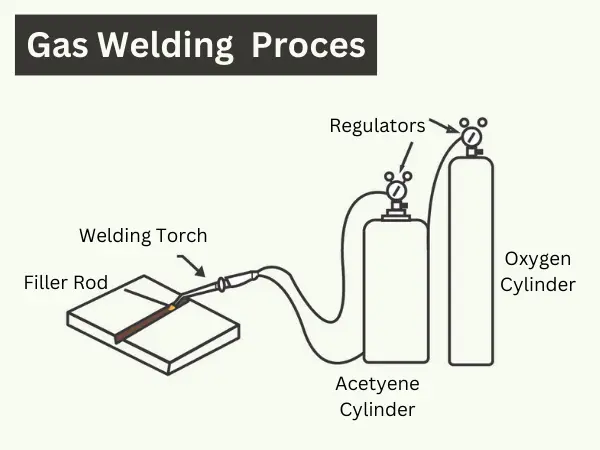
© weldingvilla.com – Image usage rights
Well, this method uses specific gasses to weld different materials. The process is based on using oxy-fuel, a combination of different gasses. The welding method uses acetylene mixed with oxygen to create a high-temperature flame for welding two metals together.
Gas welding produces heat to an intense temperature, with three different flame types: carburizing, oxidizing, and neutral. Besides that, the process is versatile, giving accessibility to any situation.
| Benefits: |
|---|
Read all the benefits of Gas welding in the below list:
|
Applications:
The process of Gas welding is suitable for both non-ferrous and ferrous metals. It is mostly used in metal artistry, plumping, and other repairs because of its versatility and portability.
Thermit Welding:
In the classification of the welding process, Thermit welding is one of the complicated welding processes that involves a chemical reaction for its welding. Its chemical reaction between aluminum powder and metal oxide then creates intense heat as an exothermic reaction. That heat then melts the metal, which joins the workpieces when it’s cooling.
It’s one of the easiest methods of welding any two metals. Compared to other welding methods, this welding method doesn’t need any power or electricity. It only needs heat, which can do its trick.
| Benefits: |
|---|
Check all the advantages of Thermit Welding in the Given list:
|
Applications:
This type of welding is mainly used in places where robust welding is required. It is used in joining railroad tracks because of its strong and continuous joints.
Forge Welding:
This is one of the old methods of welding in which two metals were heated to a high temperature and then forged and hammered together to create a weld. The process is only available and relies on the plasticity of hot metals.
This was one of the oldest welding methods, which is less precise than today’s welding. Welding by the forging method is hard, and only skilled blacksmiths can do it.
| Benefits: |
|---|
The benefits of Forge Welding are given below:
|
Applications:
The Forge Welding method was traditionally used in blacksmithing but is used less today.
FAQs:
What are the four welding processes?
The primary and most popular types of welding are given below.
- Gas Metal arc welding.
- Gas tungsten arc welding.
- Shielded metal arc welding.
- Flux-cored arc welding.
What is the best Welding process?
All of those welding are good processes, but when it comes to accuracy, gas tungsten arc welding is probably the best or highest quality of welding. But note that it’s also the most expensive welding.
What is the hardest Welding process?
When it comes to the hardest welding, it should be tungsten inert gas welding because it is hard to do and challenging to learn. This type of welding is very complex and needs proper training and practice. It is also one of the expensive ones, which also makes it hard to do.
What is the cheapest Welding process?
SMAW welding is considered the cheapest welding process because it doesn’t require any high investment and can be done by almost everyone.
Conclusion:
Exploring the rich world of welding processes unveils a lot of possibilities. Whether you are a welding enthusiast or a professional welder, delving into these methods and techniques broadens your understanding, view, and thoughts on the sciences behind joining metals.
Please visit our website for more topics like this.
Please Write Your Comments